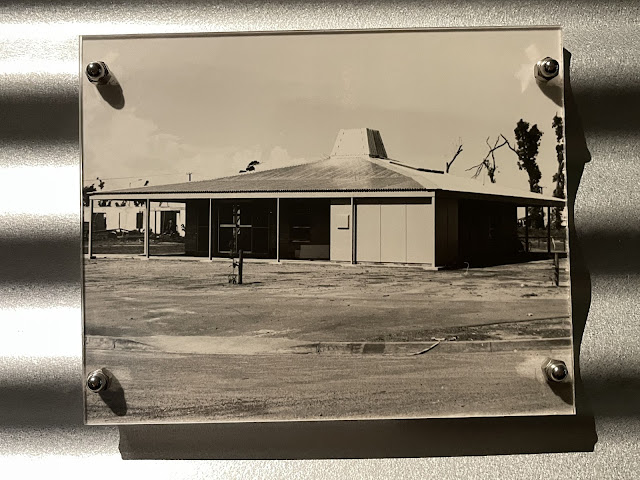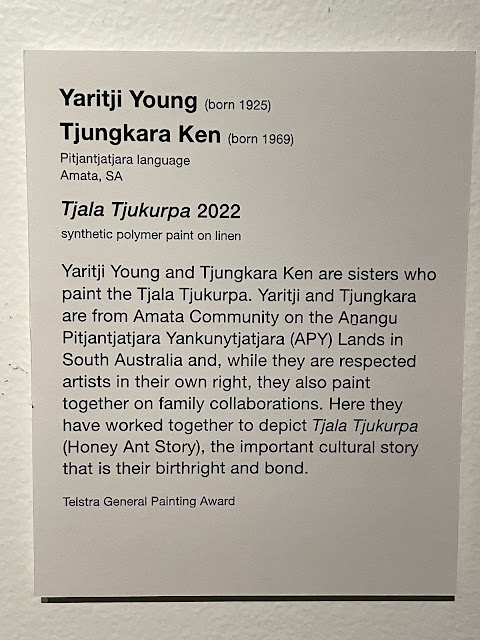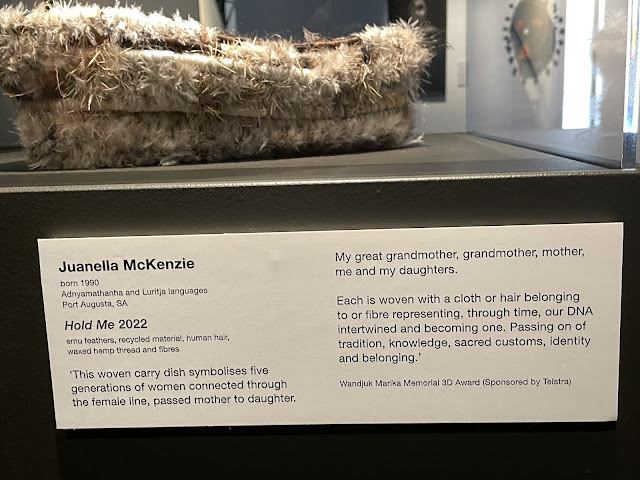DARWIN DAY 1
Can you believe it, I’ve finally caught up on our travels.
Yesterday was a day out for us, which was needed. We have decided that we need to take about a day a week as time out.
We started out by eating some of those yummy mango pieces on our cereal for breakfast.
Firstly we did the washing, which never goes away, as Jenny will attest to. Then I did some blog catch up, while Mick read his book.
After lunch I got out my sewing machine with the intention of getting some of my black and white HST blocks put together. My machine sounded like it needed some oil and of course I didn’t bring any. Also the one little light on the machine is rather weak compared to what I am used to at home. Therefore, we decided to hop in the car and find a Spotlight to fix the the situation. I now have some oil, some blue thread for my hexies, although it isn’t as fine as I would like. It will definitely do the job. It appears that an LED light is unobtainable in Darwin. Not to worry.
It was a nice lazy day.
The highlight of the day for Mick was just being lazy and for me it was getting some blue thread.
DARWIN DAY 2
After our lazy day yesterday, today we headed out to have a bit of a look around, starting off at the Military Museum. This year marks the 80th anniversary of the bombing of Darwin.
On 19 February 1942, Darwin was the first place in Australia to come under enemy attack, when it was bombed by the Japanese. This came only 10 weeks after they bombed Pearl Harbour. This time there were more than twice the number of bombs. Initially 188 Japanese aircraft were launched from four aircraft carriers, attacking and destroying much of the main wharf area and wrecking much of the town area over two hours. 21 ships and boats were were either sunk or disabled. Both the hospital and a hospital ship were attacked. Two hours later another 54 bombers attacked the RAAF (Royal Australian Air Force) base. In the two raids at least 292 people were killed with hundreds more injured. Darwin was subjected to at least a further 62 air raids up to November 1943.
There was so much information and a really informative short film about the event and what Darwin was like before the war and then during the war. One of my uncles was serving in the army in Darwin at the time.
This relic was interesting. It is a Japanese Drop Tank. They were an extra fuel tank attached externally to their Zero planes. Once the fuel was used up the tank was jettisoned, thus extending the range of the plane.
This is a silk map of the region, carried by pilots to use to assist them if they had to find their way from enemy territory. They were compact and not damaged by water.
The small item on the corner of the map are button compasses. They were disguised as trouser fly buttons for pilots to aid in finding their way in enemy territory. The top left and bottom right are a pair. One has a tiny protrusion from the centre (bottom right), while the other has a corresponding indentation. The three dots are magnetised, so true north is shown by the two dots and south by the one dot. I’m not sure how the other one works. These were designed by M19 in England and their designer may have been the inspiration for Q in the James Bond books written by Ian Fleming, as he was in military intelligence.
The museum was in beautiful shady grounds, with many of the exhibits outside or in other original buildings from WWII. The museum is on one of the military sites and came into being as some people were concerned that it was deteriorating and being vandalised. They started in the mid 1960s, it was damaged in Cyclone Tracy and then rebuilt to what it is today.
There was a huge big concrete thing that looked like a big water tank. When you went around to the other side it was actually a large gun emplacement. There were two of these 9 inch guns installed. However, they were built at a time when sea attack was much more likely than air, but, as it turned out, that wasn’t the case. They each only fired one shot, one in 1944 and one in 1945. They were ultimately cut up and sold for scrap.
Huh! But it’s here? Well, no it isn’t. This is actually a timber replica. It had us fooled until I read the sign.
There were quite a lot of weapons on display, as you would expect of a military museum. This is a Tommy Gun, which is what my Dad used in Singapore. By the way, Singapore ultimately fell to the Japanese on 15 February 1942, just four days prior to the bombing of Darwin.
Another interesting exhibit was a Briggs Ball Turret, which was installed under the fuselage of a bomber plane. In this tiny space a gunner had to lie on his back with his legs bent forward when in the firing position. He had two machine guns. It was so restricted that he would have had a special low-profile parachute.
Imagine how cramped you would get and how noisy it would be. The Turret was retracted back into the plane for landing, due to the low clearance of the plane.
After we’d had our fill of military history, we went in search of a nice lunch.
We drove along Fannie Bay on our way back to the city. It is so pretty and so quiet. No swimming here, as there are box jellyfish. There were some rather flash houses along the waterfront.
We ended up at Stokes Wharf. This is the area that was initially bombed back in 1942. There were two tug boats moored.
Look at how close you park your car to the water and there is no barrier. By the way, parking was ticketed, but free for three hours. Not bad for a city, but Darwin feels more like a country town.
We enjoyed a fish and chips lunch overlooking the water. It was rather pleasant just sitting there taking it all in and watching the world go by. Very relaxing.
After lunch we wondered if there is anything in relation to Cyclone Tracy. There is lots of mention of WWII events and sites, but no mention of Darwin’s other major event. Well, there is a section at the Art Gallery and Museum, so off we went.
Darwin was hit by an incredibly strong cyclone on 24-25 December 1974. The winds were so strong that they broke the Bureau of Meteorology’s recording instruments after recording a gust at 217 km/h but gusts were estimated at over 260k/hr based on structural damage. They had experienced a cyclone only a few weeks prior, which had caused little damage, so were rather blasé about Tracy. She came along, caused a lot of damage and then things calmed down, as the eye of the storm passed over. Then she really hit. The majority of buildings built after WWII were of fibro, so not terrible strong. The city was devastated.
I remember it well and a song “Santa Never Made it to Darwin” by Bill and Boyd. You can hear it here. The film clip has some good images of Darwin before and after Cyclone Tracy hit.
There was a photo gallery of the destruction, television news reports from the time and audio of people recalling their experiences. However, the most chilling was a sound booth. A bishop at Darwin recorded the sounds of the wind. Mick reckoned it sounded like a monster. It must have been so terrifying. Officially, 49 were killed and a further 16 lost at sea, although the unofficial estimates are much higher.
After Cyclone Tracy a new “Cyclone Code” of building was introduced with houses to have a central core area, usually the bathroom, reinforced and designed to act as a private bunker when a family could sit out a cyclone. This is just one of a number of designs available at the time.
Poor Darwin, first to be bombed and then destroyed by a cyclone. They have certainly been resilient to build it into the modern city it is today.
While we were at the museum and art gallery we visited the other exhibits. In the museum there was an interesting section on termite mounds.
There are about 70 species of termites in Australia. Most live on grasses. They have a network of passages in which they live and stash spinifex grass. They collect the grass in the dry season for the consumption during the wet season. Mounds can be up to 7 metres in height and can last for up to 80 years.
There is another type of termite, which doesn’t build mounds. It is the giant termite and lives in logs, stumps and tree trunks. They can also live in fence posts and buildings. Didgeridoos are made from tree trunks that have been eaten out by termites.
Also at the art gallery the current exhibition is “2022 Telstra National Aboriginal and Torres Strait Art Awards”. There were some beautiful pieces on display.
This was our favourite. When you looked into it, it appeared 3D. We, and others were mesmerised.
This was painted on bark.
This basket had an interesting story behind it.
Considering we didn’t have much planned for the day, we had a really nice time out and about. We’ve no idea what we will do tomorrow. That’s half the fun.
The highlight of the day for Mick was the colourful painting that appeared to be 3D at the art gallery. For me it was enjoying a leisurely lunch by the waterside.



























4 comments:
Fascinating stuff.
That was an interesting day. Reading about Bill and Boyd made me smile. Did you know they were a couple of local Hutt Valley (Wellington NZ) boys? Their big hit here was Put another log on the Fire, very tongue in cheek as male chauvinists.
I agree, you do need a rest day every now and then when in a big trip. And.....like rust, washing never sleeps, holidays or not! Luckily, as Robin always says, "you enjoy doing the washing!"
Wonderful post. Good to have a rest day.
Very informative Janice, I'm learning a lot from your posts.
Post a Comment